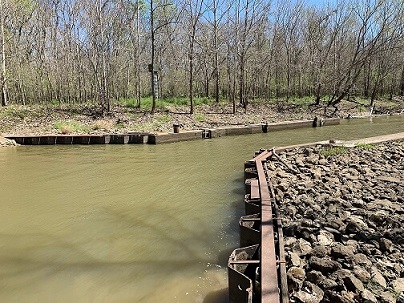Water Management Data System Menu
Wallisville Salinity Control Project-Lower Trinity River
The hydrologic conditions and the hydrologic data provided are for informational purposes only. The Corps of Engineers does not warrant the correctness or the accuracy of the hydrologic data or the hydrologic conditions presented herein. Official data can be obtained by writing to the Water Management Section, Galveston District Corps of Engineers, 2000 Fort Point Road, Galveston,TX 77550
Overview of the ProjectThe Wallisville project is located on the lower part of the Trinity River in Wallisville, TX. It is a multi-purpose project in which salinity control is a primary purpose. This project helps to prevent salt intrusion into the irrigation supplies to local rice farms as well as water that is being withdrawn by the City of Houston for municipal use. During low flow periods (flow approximately less than 2000 cfs), a salinity wedge "can" move up the river. Salinity control is achieved by operation of Wallisville project using tainter gates, sector gates and Structure ‘A’. Fresh water releases from Lake Livingston Dam (operated by Trinity River Authority) also help to prevent upstream movement of the saltwater wedge. During normal flow conditions-periods when there is no risk of saltwater intrusion and the Trinity River at Goodrich and Liberty flows are greater than 2000 cfs, the locks are routinely exercised. During normal conditions the tainter gates and the navigation lock are normally kept completely open with no effect on flow or stage. During salinity control operations, navigation locks are usually closed. When the lock gates are closed, an on-site operator is usually assigned to maintain water way navigability. Once high specific conductance and salinity are detected on the Old River Cutoff, Structure ‘A’ may also be closed. 
Hurricane Operations and Tidal Flooding• Storms or coastal surge events often result in high stream velocity and high salinity. • The controlled spillway gates were designed to resist at least 75 miles per hour winds and associated waves so that routine closing during river floods will not be required. • During minor storms and minor high tide events the spillway gates are normally left open unless salinity intrusion is imminent. Emergency Operation Procedures
The folowing emergency operation
procedures/guidelines are followed during an
emergency:
Consideration for closure of the tainter gates
(controlled spillway), the locks and structure A
depends on how these structures will respond to the
type of event that is expected. The following
guidelines are often used:
Returning From Evacuation• When returning from an evacuation, If the project has been flooded by tidal water or river flows, all spillway gates are usually opened to allow floodwater to exit. • The gates however are not opened until hurricane wind conditions subside and there is capacity on the downstream side of the Trinity River, thus not allowing storm surge back into the project area. • The flood level at the project is less than about +7.0 ft NGVD. The gates are normally opened in a rotational sequence starting with the innermost gates with each gate opened 4 ft in turn until all gates are fully opened. • All gates are usually kept open to allow exit of floodwater until flooding conditions subside if storm surge is not back into the project area. Subsequent Operation• When the Trinity River flow to Trinity Bay is equal to or greater than 2,000 cfs, normal operations with all gates and lock opened are often enforced. • However, if the Trinity River flow to Trinity Bay is less than 2,000 cfs, monitoring is resumed followed by salinity control operations if necessary. Flushing• Flushing is often required when saline water moves upstream of the project and the navigation lock,and controlled spillway are closed). • Flushing of saline water that has moved upstream is performed through the controlled spillway and navigation locks. During normal to flood flows, flushing is not a problem. • The upstream area may be inundated with saline tide waters (possibly by a storm surge) and these waters will be flushed out of the project area under normal and flood flows. • However when the upstream area is inundated with saline tide waters without the accompanying fresh water flows (ie: a “dry” hurricane), freshwater releases from Lake Livingston are often required to help flush the saline water out of the project area within an appropriate time. • When planning to perform flsuhing operations, salinity is monitored to establish flushing requirements. |
Water Control Manual-Wallisville Project
The official water control manual for the Wallisville Project is in preparation. It will be published as soon as it is completed and approved by USACE.



